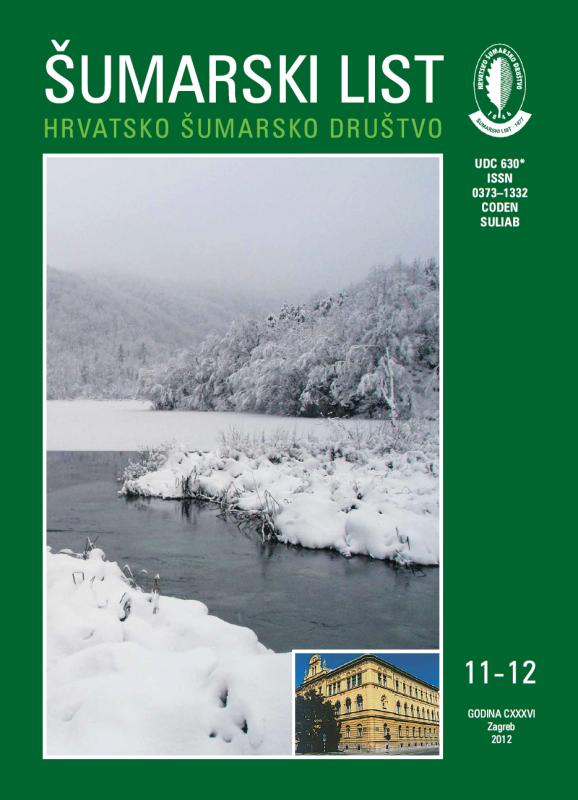
broj: 11-12/2012
pdf (4,44 MB) |
|
||||||||||||||
| RIJEČ UREDNIŠTVA | ||
| Uredništvo | ||
| AT THE END OF THE YEAR pdf HR EN | 557 | |
| IZVORNI ZNANSTVENI ČLANCI | ||
| Jozo FRANJIĆ, Željko ŠKVORC, Daniel KRSTONOŠIĆ, Krunoslav SEVER, Ivana ALEŠKOVIĆ | UDK 630*165+187 (001) | |
| VEGETATION FEATURES OF LITTORAL BEECH FORESTS (Seslerio autumnali-Fagetum M. Wraber ex Borhidi 1963) AND PREMONTANE BEECH FORESTS (Ranunculo platanifoliae-Fagetum Marinček et al. 1993) IN THE AREA OF UČKA NATURE PARK pdf HR EN | 559 | |
| Marilena IDŽOJTIĆ, Marko ZEBEC, Igor POLJAK, Zlatko ŠATOVIĆ, Zlatko LIBER | UDK 630*165 (Castanea sativa Mill.) (001) | |
| ANALYSIS OF THE GENETIC DIVERSITY OF "LOVRAN MARRON" (Castanea sativa Mill.) USING MICROSATELLITE MARKERS pdf HR EN | 579 | |
| Dalibor BALLIAN, Faruk BOGUNIĆ, Osman MUJEZINOVIĆ, Davorin KAJBA | UDK 630*165 (Fagus sylvatica L.) (001) | |
| GENETIC DIFFERENTIATION OF EUROPEAN BEECH (Fagus sylvatica L.) IN BOSNIA AND HERZEGOVINA pdf HR EN | 589 | |
| Summary: European beech (Fagus sylvatica L.) is one of the most important forest tree species in Bosnia and Herzegovina from both the economic and ecological aspect. Bosnia and Herzegovina has 3,231,500 ha of forests and forestland, accounting for about 60 % of its total area. In the structure of forests and forestland, high forests cover 51.10 %, coppices 38.70 %, scrubland 4.00 %, bare land and clearings 5.80 % of the total forest area, while other unproductive areas account for 0.40 %. In addition, European beech also occurs in mixed forests of beech and fir, and beech, fir and spruce, which is 46 % of all high forests. Consequently, the total area of forests featuring European beech is about 1,652,400 ha. The European beech (Fagus sylvatica L.) showed very good horizontal stratification in Bosnia and Herzegovina. It grows, in combination with Sessile oak (Fagetum submontanum), in the lowest forest belts, further it can be found in hills, where it forms pure stands (Fagetum montanum), and finally in mountain areas, mixed with common fir or with both fir and spruce, forming most important community of mixed beech and fir forests (Abieti fagetum). The forests growing in the Central Dinarides are very specific; on a very small space there is a broad variety of climate, edaphic, orographic and other factors which all have direct influence on the differentiation of various ecotypes. Biochemical analysis of genetic structure of eight beech populations using 16 isoenzyme gene loci provided significant genetic differentiation. In some of the gene loci variability was high, whereas in some populations monomorphism was identified only for some gene loci. The average number of alleles per locus ranged from 2.3750 in the Velež population to 2.7500 in the Dinara population, while the average number of genotypes in a locus ranged from 2.8750 in the Posušje population to 3.5625 in the Dinara population. The highest heterozygocity was found in the Čemerno population and the lowest in the Velež population. Some of the observed alleles, such as Pgi-B1, represent rare allelles, which is very useful for subsequent determination of seed and plant material provenance, and indicates specific stand markers. Apart from their importance in determining the origin of forest reproductive material, they are also vital for the successful application of management measures. The negative fixation index values in the studied seed stands are indicators of more liberal management. They would not lose much of their genetic potential for adaptation since they possess sufficient genetic variability, as confirmed by this research. Genetic multilocus diversity ranged from 55.26 to 185.29, and genofund diversity was between 1.2000 and 1.3616. The obtained parameter of mean differentiation for all the populations was relatively low and amounted to Dj = 4.86. This parameter indicates the proportion of total diversity and can be assessed with about 95.14 %. This value is conditioned by inter-population and intra-population genetic diversity and by lower differentiation between the populations. The highest differentiation was found in the Posušje population (Dj = 7.58), which points to its high stability and homogeneity in comparison with other populations from this research. In order to maintain natural genetic resources of European beech in Bosnia and Herzegovina, it should be establish dense network of gene banks in situ and ex situ (seed zones, seed stands, clonal and seedling seed orchards), which are necessary for maintaining genetic diversity of the populations. On the basis of research each important ecological niche for European beech should have its gene bank, with appropriate collection of genotypes, in order to preserve ecological and physiological features of the populations. Since only partial genetic structure of European beech in Bosnia and Herzegovina was provided by this research, further study is needed in order to perform genetic distribution of seed units of this valuable commercial species. Particular attention should be paid to the delineation of provenances (seed stands), as well as to experimental division based on provenance tests and the study of ecological-physiological properties. Key words: European beech; izoenzymes; genetic diversity and diff erentiation | ||
| PRETHODNO PRIOPĆENJE | ||
| Stefan WIRTH Milan PERNEK | UDK 630*443 | |
| FIRST RECORD OF THE MITE Histiostoma ulmi IN SILVER FIR AND INDICATION OF A POSSIBLE PHORETIC DISPERSAL BY THE LONGHORN BEETLE Acanthocinus reticulatus pdf HR EN | 599 | |
| STRUČNI ČLANCI | ||
| Damira TAFRA, Marija PANDŽA, Milenko MILOVIĆ | UDK 630*174 | |
| WOODY PLANTS OF THE OMIŠ pdf HR EN | 607 | |


